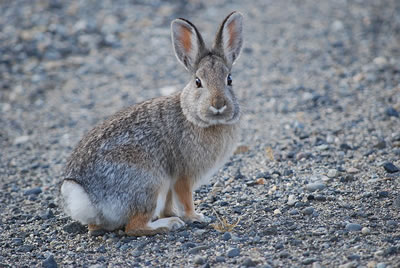Rabbits
Facts about creatures
- Home
- Animal Classification
- Animal Habitats
- Amphibians
- Arthropods
- Bats
- Birds
- Carnivorans
- Cetaceans
- Chordates
- Crustaceans
- Dinosaurs
- Diprotodonts
- Elephants
- Fish
- Golden Mole
- Insects
- Lagomorphs
- Mammals
- Mammal Teeth
- Marsupial Mole
- Metamorphosis
- Mollusks
- Primates
- Reptiles
- Rodents
- Ruminants
- Soricomorphans
- Tenrec
- Tetrapods
- Vertebrates
Rabbits
Rabbits and hares together make up the family Leporidae.
Rabbits live in many different habitats around the world, including forest, grasslands, meadows, swamps and deserts.
They often live in underground burrows that are known as warrens.
Rabbits are social animals and live in groups of up to twenty.

They have long ears, which help them detect predators.
Their hind legs are big and strong.
Rabbits move on the tops of their toes. An animal that walks on the tips of its toes is known as a digitigrade.
This method of locomotion enables the rabbit to run very quickly.
A rabbit’s diet primarily consists of grass.
Rabbits are altricial. This means that when they are born, they cannot move around on their own.
Newborn rabbits are blind and hairless.
Unlike rabbits, hares are precocial (able to move on their own as soon as they are born).
A baby rabbit is known as a kitten or kit.
Rabbits in Australia
Because rabbits reproduce very rapidly, they have caused problems when they were introduced to places where they had no natural predators.
This happened during the British colonization of Australia. When rabbits were brought over from Europe, they reproduced so rapidly that they were considered a plague.
In the 1950s, scientists introduced myxomatosis, a virus that is fatal to rabbits, to the Australian rabbit population.
Many rabbits died.
Those that survived were resistant to myxomatosis.
In the 1990s, another virus, known as rabbit calicivirus (RCV), or rabbit hemorrhagic disease (RHD) was introduced to the rabbit population.
Rabbits also developed resistance to this disease.
Currently, scientists are trying to find ways to make rabbits in Australia sterile.
Sumatran Striped Rabbit
The Sumatran striped rabbit, also known as the Sumatran short-eared rabbit, lives in the mountains of western Sumatra, in Indonesia.
It has a gray coat with brown stripes. Its tail is red and its underbelly is white.
This coloration makes it difficult for predators to see it against dark-colored volcanic soil.
The Sumatran striped rabbit usually eats the leaves and stalks of plants. It sometimes eats fruit, when it is available.
It is considered a critically endangered species.